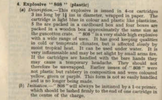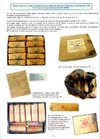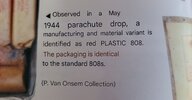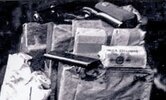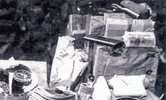British Ordnance Collectors Network
You are using an out of date browser. It may not display this or other websites correctly.
You should upgrade or use an alternative browser.
You should upgrade or use an alternative browser.
PE No.2 and Nobels 808 sizes?
- Thread starter turpin42
- Start date
Thanks for posting that Anders. It almost looks like clothing line.
Yes but do not make that mistake, :tinysmile_classes_t
Old conversation but it seems there is still a controversy over the sizes of the WW2 PE and 808. Yodamaster said PE was 19.5 x 3.5 x 226.8 grams (7.7 inch x 1 3/8 x 8 ounce).
And 808 was 7.62 x 4.49 x 113.4 g (3 inch x 1 3/4 x 4 ounce). Bigger diameter.
David Gordon in his great book says P.E. was 1 3/8 inch x 4 for a 4 ouncer. Pretty close to Yodamaster's numbers.
But David said 808 was 1 3/8 x 3 inch for a 4 ouncer. Was it 1 3/8 or 1 3/4? Is there a typo somewhere?
When you look at the photo from Anders, post #48, which I assume is a genuine cartridge of PE2 from the period (if not please say so), it is about the same aspect ratio (shape) as this:

This is one I made that is 1 3/8 x 8 inch.
This also looks the same as one on the ICI display board posted by exat808, post #6, second row from the bottom, third from left. Note there are others that are longer. Are diameters the same? I wonder if some of these are over 8 inch long? Maybe he can tell us which are 808 or PE.
I wonder if there were 1 1/4 inch diameter cartridges at that time? Main question here is about diameter.
And 808 was 7.62 x 4.49 x 113.4 g (3 inch x 1 3/4 x 4 ounce). Bigger diameter.
David Gordon in his great book says P.E. was 1 3/8 inch x 4 for a 4 ouncer. Pretty close to Yodamaster's numbers.
But David said 808 was 1 3/8 x 3 inch for a 4 ouncer. Was it 1 3/8 or 1 3/4? Is there a typo somewhere?
When you look at the photo from Anders, post #48, which I assume is a genuine cartridge of PE2 from the period (if not please say so), it is about the same aspect ratio (shape) as this:

This is one I made that is 1 3/8 x 8 inch.
This also looks the same as one on the ICI display board posted by exat808, post #6, second row from the bottom, third from left. Note there are others that are longer. Are diameters the same? I wonder if some of these are over 8 inch long? Maybe he can tell us which are 808 or PE.
I wonder if there were 1 1/4 inch diameter cartridges at that time? Main question here is about diameter.
Last edited:
It is original.When you look at the photo from Anders, post #48, which I assume is a genuine cartridge of PE2 from the period (if not please say so), it is about the same aspect ratio (shape) as this:
I'm bringing this thread up again to add a few reference pictures, since there seems to be a couple discrepancies between measurements mentioned so far. Attached are pictures of original Nobel's No. 808. wrappers showing the measurements from crease to crease. This gives us an idea of the actual length of each stick. I have five of the 808. wrappers, and based on the crease measurements, they would have all been about 9cm, or 3 5/8" inches long.
Unfortunately I cannot determine the original diameter of each stick using the wrappers, so I am going to assume they were 1 1/4" inch in diameter, based on the Royal Engineers Demolition Chart uploaded by sgdbdr in post #64.
Unfortunately I cannot determine the original diameter of each stick using the wrappers, so I am going to assume they were 1 1/4" inch in diameter, based on the Royal Engineers Demolition Chart uploaded by sgdbdr in post #64.
Attachments
Last edited by a moderator:
Here are reference pictures for a stick of P.E. No.2 showing the length based on a measurement from crease to crease. This is the only wrapper I have for P.E. No.2, but based on this, the length of the stick would have been 8" inches. Again for the diameter I would need to refer to the chart in post #64, which states that a stick of P.E. No.2 had the same diameter as the sticks of Nobel's No. 808., which is 1 1/4" inches.
Attachments
Last edited:
I have two guenuine PE2 papers.
I made an inert petard with the best paper, but too quickly and the result is a diameter of 3.5cm (pic1).
On the picture 2 we can see the old mark of the original folding, so 3.5cm diam is too wide (pic2).
The former outer folds show that the length was approximatly 20cm.
So official dimensions 8inx1.25in match.
I also made measurments of the second paper (in bad condition) (pic3)



I made an inert petard with the best paper, but too quickly and the result is a diameter of 3.5cm (pic1).
On the picture 2 we can see the old mark of the original folding, so 3.5cm diam is too wide (pic2).
The former outer folds show that the length was approximatly 20cm.
So official dimensions 8inx1.25in match.
I also made measurments of the second paper (in bad condition) (pic3)


Last edited:
Old thread, great info despite conflicts about the 808 cartridge diameters.
WWIIBuff probably got the answer already to his question about what 808 felt like, for his reproduction project. Personally I liked using wood dowels for my display because they can't be confused with plastic explosives if inspected by a law enforcement officer. For example, painting modeling clay with almond extract so it smells like 808 would be over the top! Even if the LEO doesn't know what PE2, Comp C, 808, Gelignite, TNT, or dynamite is supposed to feel like, the cartridge can simply be unwrapped to show the wood. Give it a good rap on the table to make it sound like it. Have a wood saw handy to demonstrate sawdust.
On mine I rounded the ends somewhat which is probably how the original cartridges looked after wrapping, boxing, and handling. The wrapper reflects that roundness somewhat. I also drilled a hole in both ends in case I want to insert a (dummy) detonator. I use a Phillips head screwdriver as a rectifier to punch through the wrapper (I realize a 1 ounce primer was recommended to be used between det and HE).
I have read the early 808 was like rubber and I take that to mean somewhat springy. I don't know what "early" means. Pre-war? Some say the red stamped markings were early and blue later. Some say blue indicates a product better for sub-freezing temperatures, because that is noted on shipping boxes.
Back to the feel - later war 808 is said to feel like plasticine. To an American like me that means modeling clay. Moldable, not rubbery. Kneading makes it softer, as would adding Vaseline or heating it in a pocket or under the arm pit. The ordnance veterans on here can confirm that. So if one wants to completely simulate 808, use the type of modeling clay that does not harden, even in air. Other types might harden, certainly if baked. When I made my replica SAS Lewes Bombs, one is a cutaway showing the ball with buried "guncotton" primer (a cork) and "detonator" (aluminum tube), and "Cordtex" (plastic clothes line), I put the clay pieces under a heat lamp to harden so they are more durable when I take it out of the ration bag to show people.
WWIIBuff probably got the answer already to his question about what 808 felt like, for his reproduction project. Personally I liked using wood dowels for my display because they can't be confused with plastic explosives if inspected by a law enforcement officer. For example, painting modeling clay with almond extract so it smells like 808 would be over the top! Even if the LEO doesn't know what PE2, Comp C, 808, Gelignite, TNT, or dynamite is supposed to feel like, the cartridge can simply be unwrapped to show the wood. Give it a good rap on the table to make it sound like it. Have a wood saw handy to demonstrate sawdust.
On mine I rounded the ends somewhat which is probably how the original cartridges looked after wrapping, boxing, and handling. The wrapper reflects that roundness somewhat. I also drilled a hole in both ends in case I want to insert a (dummy) detonator. I use a Phillips head screwdriver as a rectifier to punch through the wrapper (I realize a 1 ounce primer was recommended to be used between det and HE).
I have read the early 808 was like rubber and I take that to mean somewhat springy. I don't know what "early" means. Pre-war? Some say the red stamped markings were early and blue later. Some say blue indicates a product better for sub-freezing temperatures, because that is noted on shipping boxes.
Back to the feel - later war 808 is said to feel like plasticine. To an American like me that means modeling clay. Moldable, not rubbery. Kneading makes it softer, as would adding Vaseline or heating it in a pocket or under the arm pit. The ordnance veterans on here can confirm that. So if one wants to completely simulate 808, use the type of modeling clay that does not harden, even in air. Other types might harden, certainly if baked. When I made my replica SAS Lewes Bombs, one is a cutaway showing the ball with buried "guncotton" primer (a cork) and "detonator" (aluminum tube), and "Cordtex" (plastic clothes line), I put the clay pieces under a heat lamp to harden so they are more durable when I take it out of the ration bag to show people.
Old thread, great info despite conflicts about the 808 cartridge diameters.
WWIIBuff probably got the answer already to his question about what 808 felt like, for his reproduction project. Personally I liked using wood dowels for my display because they can't be confused with plastic explosives if inspected by a law enforcement officer.
I ended up using wood dowels for the interior of my .808 charges as well. It was easier to work with and will hold the shape of the original wrappers better. Plus I will never be unwrapping them, so I did not see a reason to worry about what the inside look like.
Based on this excerpt from the 1945 Field Engineering (All Arms) Military Training Manual that you posted for me on another thread, it sounds like the blue-labeled wrappers were the earlier version .808 Explosive, and the red-labeled wrappers were from the later Plastic .808. That might explain why the blue-labeled wrappers seem to be more common these days, they were not used as much after becoming obsolete, so there were more leftovers.
Attachments
It says blue but probably means the color of the HE itself.I ended up using wood dowels for the interior of my .808 charges as well. It was easier to work with and will hold the shape of the original wrappers better. Plus I will never be unwrapping them, so I did not see a reason to worry about what the inside look like.
Based on this excerpt from the 1945 Field Engineering (All Arms) Military Training Manual that you posted for me on another thread, it sounds like the blue-labeled wrappers were the earlier version .808 Explosive, and the red-labeled wrappers were from the later Plastic .808. That might explain why the blue-labeled wrappers seem to be more common these days, they were not used as much after becoming obsolete, so there were more leftovers.
What's the best wrapper marking color for, say, 1942-1944 period? Opinions?
Correct, I was just referencing the fact that the blue-labeled wrappers did not contain the "plastic" .808 that came later, not the color of the explosive material itself.
For the 1942-1944 period I would say that the blue wrappers would be the most accurate. From the information I have found so far, it sounds like the red-labeled "Plastic" 808 did not come on the scene until mid 1944.
Here is a scan of a page from the French SOE reference book Tombé du ciel ! (Dropped From The Sky) by Eric Pierret referencing both types of 808. I have also included a translation of his verbiage about the red-labeled Plastic 808.
For the 1942-1944 period I would say that the blue wrappers would be the most accurate. From the information I have found so far, it sounds like the red-labeled "Plastic" 808 did not come on the scene until mid 1944.
Here is a scan of a page from the French SOE reference book Tombé du ciel ! (Dropped From The Sky) by Eric Pierret referencing both types of 808. I have also included a translation of his verbiage about the red-labeled Plastic 808.
Attachments
Thanks for that image and translation. If the original recipe for 808 was rubbery, it must have been moldable into shapes because that was the goal, as it was for Gelignite before it. The term "plastic" is introduced during the war at some point and I wonder if 808 labeled that way was no different than the version invented in the 1930s. I mean it always was plastic. But was it more putty-like, like modelling clay, and not as rubbery which might mean springy, like the early version was said to be?Correct, I was just referencing the fact that the blue-labeled wrappers did not contain the "plastic" .808 that came later, not the color of the explosive material itself.
For the 1942-1944 period I would say that the blue wrappers would be the most accurate. From the information I have found so far, it sounds like the red-labeled "Plastic" 808 did not come on the scene until mid 1944.
Here is a scan of a page from the French SOE reference book Tombé du ciel ! (Dropped From The Sky) by Eric Pierret referencing both types of 808. I have also included a translation of his verbiage about the red-labeled Plastic 808.
808 in 1940-41 was moldable. It was the filling in the 29mm Spigot Mortar (Blacker Bombard) 20 pound anti-tank round which used the HESH principle (High Explosive Squash Head), sometimes called a poultice charge. The thin steel bomb flattened against the target before the base fuse set it off. The shock wave travelled through the steel, causing the inner surface to bulge and "scab" shrapnel would fly inward. The SOE Tree Spigot Gun used a similar warhead and the giant "Flying Dustbin" demolition round fired by AVRE tanks was similar. I believe it was filled with 808 in the front with Pentolite behind it (PETN+TNT). The SAS used moldable HE in late 1941 when they invented their Lewes Bomb. Probably it was 808 but it could have been Gelignite. It was a pound of HE, 1/4 pound of thermite, and motor oil, worked into a ball shape l around a guncotton primer, detonator, and Cordtex tail.
Here is another photo that might help answer your question about which label would be more accurate for the 1942-1944 period. These are cropped close-ups from an image in the book "SOE Equipment Air Dropped In Europe 1940-1945" by Anders Thygesen and Michael Sode. The full image is one of a couple published in the book showing SOE equipment that was recovered by the Germans from a failed parachute drop mission in Denmark during July 1942 called Barholme.
Although not very clear, you can make out a partial stick of Nobel's .808 in the upper right corner of the stack of equipment. I think the image is clear enough to ascertain that is was Nobel's .808, and not .808 Plastic.
Although not very clear, you can make out a partial stick of Nobel's .808 in the upper right corner of the stack of equipment. I think the image is clear enough to ascertain that is was Nobel's .808, and not .808 Plastic.











